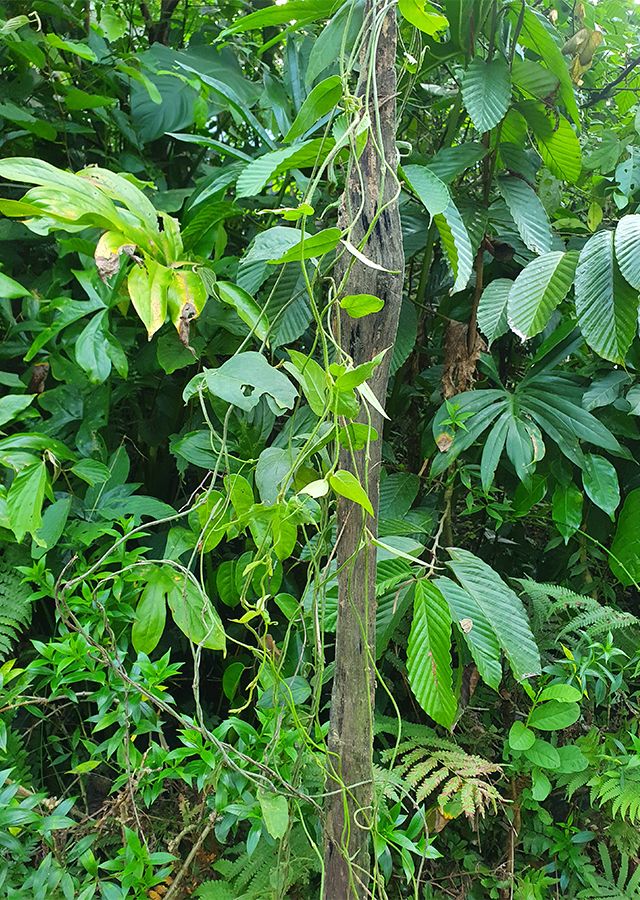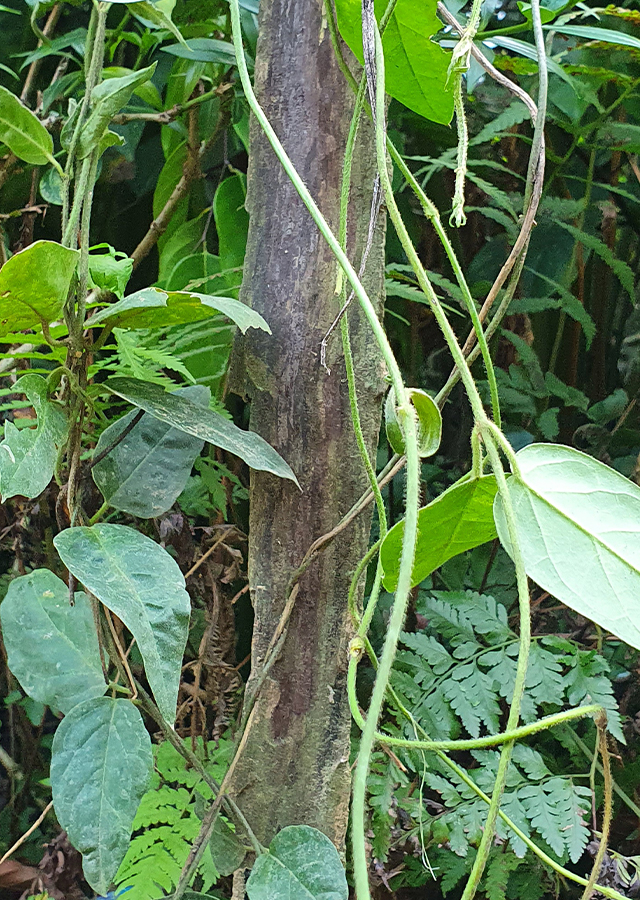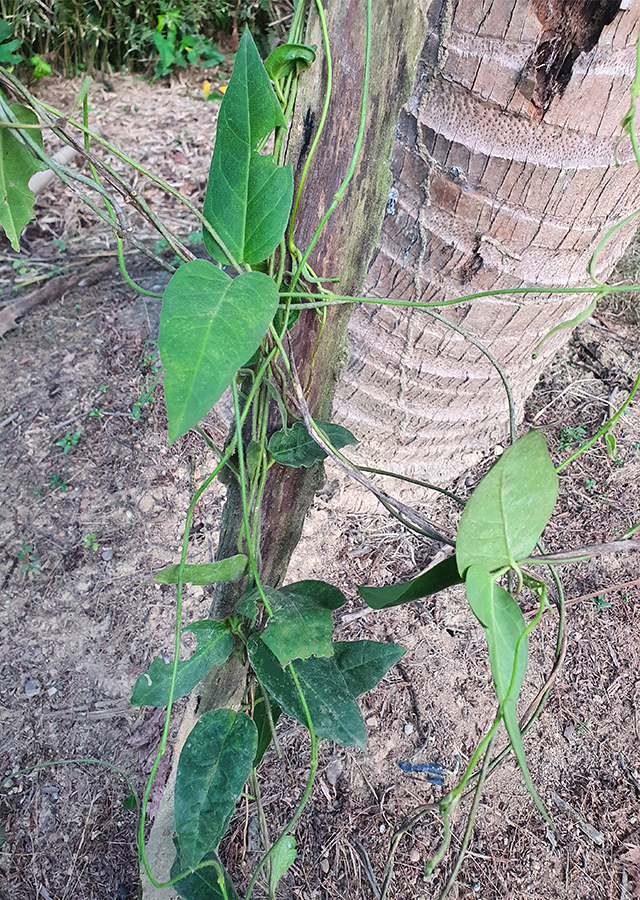Indian Ipecac
Vincetoxicum indicum (Burm.f.) Mabb.
Apocynaceae
Location in our garden
Principal



Synonym
Cynanchum indicum Burm.f.
Tylophora indica (Burm.f.) Merr.
Habitus
Climbers. A slender, twining or climbing perennial herb up to 3 m long.
Part Used
Leaves
Roots
The Whole Plant
Growing Requirements
Full Sunshine
Need Shade
Habitat
Forest
Coastal
Overview
Vincetoxicum indicum is native to Indian Subcontinent to West Malesia, and is widely distributed in Africa, Asia, Australia, and Oceanic islands. The plant has been extensively used in Ayurveda and Siddha system of medicines since long and is known in local communities with a variety of vernacular names. In India the roots of Vincetoxicum indicum are widely traded for medicinal purposes. A fine, silky, strong fibre is obtained from the stems.
Vernacular Names
Ipéca sauvage (French), Antamul (Hindi).
Agroecology
Vincetoxicum indicum occurs mainly along the coast on sandy soils, particularly on stabilized dunes and in sandy coconut plantations, from sea-level up to 900 m altitude. The plant can flourish in areas where annual rainfall is about 1,000–1,500 mm, and optimum temperature, 5-25 °C. It flowers and fruits throughout the year if sufficient water is available
Morphology
- Root - rhizomes short, 3–4 mm thick, knotty, roots numerous, fine.
- Leaves - opposite, simple and entire; stipules absent; petiole 1–2 cm long; blade ovate-oblong to almost circular, 3-8(-10) cm × 1.5-6(-8) cm, base cordate or rounded, apex acute or obtuse, papery.
- Flower - inflorescence an axillary umbel-like cyme or sometimes 2 superposed umbellate cymes, shorter than or as long as the leaves, few to many-flowered. Flowers bisexual, regular, 5-merous; pedicel 1.5-4 cm long, slender, short-hairy; sepals narrowly triangular, 1.5-2.5 mm long, apex acute; corolla pale yellowish-green, 1-1.5 cm in diameter, lobes ovate, 5-6.5 mm long, fused at base, apex rounded, glabrous outside, sparsely hairy inside; corona existing of 5 thickened lobes, obovate, up to 1.8 mm long, fused partly to staminal column, long acuminate at apex; anthers with small membranaceous appendix at apex; ovary semi-inferior, 2-celled, style columnar, stigmatic head 5-sided, c. 0.8 mm in diameter.
- Fruit - a pair of spreading follicles, each ellipsoid, 5–10 cm long, apex tapering, many-seeded.
- Seeds with coma of white hairs.
Cultivation
It is propagated by seed (generative propagation), and by in vitro multiplication techniques.
Chemical Constituents
Alkaloids, saponins, phytosterols, tannins, terpenoid, stigmasterol, β-sitosetrol, tetratriacontanol, octaosanyl octacosanoate, quercetin, α– and β–amyrins.
Traditional Medicinal Uses
- It is traditionally used as a folk remedy in certain regions of India for the treatment of bronchial asthma, inflammation, bronchitis, allergies, rheumatism and dermatitis, also for jaundice, gout and snakebite.
- Studies have shown anti-asthmatic, antibacterial, antipsoriasis, antimicrobial, antiulcer, antiallergic, antidiarrhoeal, hypolipidemic, and anxiolytic properties. Antidiabetic, hepatoprotective, antiangiogenic, antitumor, antioxidant, anticonvulsant, antirheumatic, and diuretic activities.
Part Used
Reference Sources
- Fern, Ken. (2021). Useful Tropical Plants: Tylophora indica. http://tropical.theferns.info/viewtropical.php?id=Tylophora+indica. 17-05-2022.
- Flowers of India. (No date). Indian Ipecac. http://www.flowersofindia.net/catalog/slides/Indian%20Ipecac.html. 17-05-2022.
- Kew Royal Botanic Gardens. (No date). Plants of the World Online: Vincetoxicum indicum (Burm.f.) Mabb. https://powo.science.kew.org/taxon/urn:lsid:ipni.org:names:77164260-1. 17-05-2022.
- Nazar, S., Hussain, M.A., Khan, A., Muhammad, G., and Bukhari, S.N.A. (). Alkaloid-rich plant Tylophora indica; current trends in isolation strategies, chemical profiling and medicinal applications. Arabian Journal of Chemistry, Vol.13(8): 6348-6365
- Schmelzer, G.H. (2014). Tylophora indica (PROTA). https://uses.plantnet-project.org/e/index.php?title=Tylophora_indica_(PROTA)&mobileaction=toggle_view_desktop. 17-05-2022.


